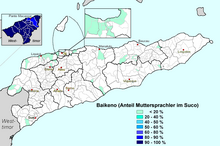Uab Meto
| Uab Meto (Baikeno, Dawan) | ||
|---|---|---|
|
Spoken in |
Indonesia , East Timor | |
| speaker | 600,000 | |
| Linguistic classification |
|
|
| Official status | ||
| Other official status in |
|
|
| Language codes | ||
| ISO 639-3 |
aoz |
|
Uab Meto ( Dawan ) is the language of the Atoin Meto in the west of the island of Timor .
Overview
Like most languages in Timor, the Uab Meto ( literally "the native language") belongs to the large group of Malayo-Polynesian languages , namely to their West Indonesian branch. Depending on the perspective, this language is now also known as Dawan , whereby the term Dawan is a foreign name used in the bureaucracy and in the cities, Uab Meto is the ethnic name. There is no etymological information about the origin of the term Dawan , which serves as a derogatory term for both ethnicity and language.
Speakers and dialects
With around 600,000 speakers, the Uab Meto is the Timorese language with the most native speakers and the dominant language of West Timor . Tetum , which is mainly spoken in the state of East Timor , has more speakers, but there are many who use it as a second language. The Uab Meto was not a written language until the middle of the 20th century, when a dialect became the standard of the modern written language. However, the regional dialects are so different from one another that speakers of both dialects only settle in the area of the territorial borders. The regional dialects are not necessarily understandable among each other. The main dialects of the Uab Meto are:
a) Amarasi (south-west Timor , district of Kupang )
b) Molo and Miomaffo (districts of south- central and north-central Timor )
c) Amanuban and Amanatun (district of south- central Timor )
d) Insana and Biboki (district of north-central Timor )
e) Baikeno ( east Timorese exclave Obene-Cus )
The dialects in the Indonesian part of West Timor follow the ancient empires and present-day regions of Amanuban , Amanatun , Amarasi , Biboki , Insana , Miomaffo and Molo .
The Baikeno dialect is the language of the East Timorese exclave Oe-Cusse Ambeno. This is also the name under which this dialect is recognized as one of the 15 national languages of East Timor in its constitution . While some sources cite Baikeno as the dialect of the lowland people and Uab Meto as the language of the mountain people of Oe-Cusse Ambeno, most of the inhabitants of the exclave seem to use these two terms as synonyms for the language. The Uab Meto in Oe-Cusse Ambeno is less influenced by Indonesian loanwords and sentence structure than in the rest of West Timor. There are differences from village to village within a few kilometers. 69,190 residents of East Timor speak a dialect of the Uab Meto as native speakers.
construction
Most of the roots of the Uab Meto consist of two syllables, with the emphasis on the first syllable. If the first syllable ends in [a] or [e], the [e] of the first syllable is always short and is hardly stressed, as in meto (dry), pena (corn), ane (dry rice) etc. If the second syllable ends on the other hand on [i] or [u], the [e] of the first syllable is long, closed and unstressed, as in menu (bitter), peti (box) etc. Omnipresent metathesis in everyday language and everyday life is a characteristic feature of the spoken Uab Meto. In linguistics, metathesis means the swapping of consonants within a word: atoni - Atoin Meto (man, person - local), neno - neon mese (day, sun - first day of the week, Monday), usi - uis neno (prince - prince des Himmels, Gott) etc. As the examples show, the qualification requires a metathesis on the noun (Regens).
numbers
1 mese
2 nua
3 teun
4 haa
5 niim
6
no 7 hiut
8 faun
9 sio
10 boés
Web links
- Dictionary Uab Meto - English ( Memento of February 16, 2005 in the Internet Archive )
- Short summary of a grammar of the Uab Meto in German
- The Languages of East Timor: Some Basic Facts ( January 19, 2008 memento in the Internet Archive )
- Dictionary Portuguese-Baikeno
Individual evidence
- ↑ Laura Suzanne Meitzner Yoder: Custom, Codification, Collaboration: Integrating the Legacies of Land and Forest Authorities in Oecusse Enclave, East Timor , p. 38 ( Memento of March 7, 2007 in the Internet Archive ), Yale University 2005 (PDF file; 1.46 MB)
- ↑ Direcção-Geral de Estatística : Results of the 2015 census , accessed on November 23, 2016.

